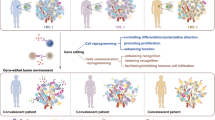Abstract
The use of tumor-specific microRNA loss to inhibit transgene expression in normal cells is considered as a way to increase the specificity of gene-therapeutic antitumor drugs. This method assumes the introduction of recognition sites of suppressed in tumor cells microRNAs into transgene transcipt. In the presented work, the efficiency of the strategy for providing the tumor specificity of transgene expression depending on parameters of microRNA expression in normal and tumor cells was studied. It was established that microRNA suppression in tumor cells and the determination of absolute microRNA levels in tumor and normal cells are not sufficient for the adequate estimation of the possibility of specific microRNA usage in the scheme of cancer gene therapy, and particularly do not allow to exclude a significant decrease in the efficiency of the gene-therapeutic drug upon the introduction of microRNA recognition sites. These parameters are only suitable for the preliminary selection of microRNA. The effect of introduction of microRNA recognition sites on transgene expression level in target tumor cells should be validated experimentally. It is suggested that this should be done directly in the cancer gene therapy scheme with monitoring of the therapeutic transgene activity.
Similar content being viewed by others
Abbreviations
- 3'-UTR:
-
3'-untranslated region
- 5FC:
-
5-fluorocytosine
- CD:UPRT:
-
yeast hybrid protein cytosine deaminase: uracil-phosphoribosyltransferase
References
Dorer D.E., Nettelbeck D.M. 2009. Targeting cancer by transcriptional control in cancer gene therapy and viral oncolysis. Adv. Drug Deliv. Rev. 61, 554–571.
Shepelev M.V., Korobko E.V., Georgiev G.P., Sverdlov E.D., Korobko I.V. 2011. Application of mRNA regulatory regions to improve tumor specificity of transgene expression. Cancer Gene Ther. 18, 682–684.
Korobko I.V. 2014. MicroRNAs in cancer gene therapy: Another look. Curr. Cancer Ther. Rev. 10, 271–276.
Jin H., Lv S., Yang J., Wang X., Hu H., Su C., Zhou C., Li J., Huang Y., Li L., Liu X., Wu M., Qian Q. 2011. Use of microRNA Let-7 to control the replication specificity of oncolytic adenovirus in hepatocellular carcinoma cells. PLoS ONE. 6, e21307.
Kuzmin D.V., Vinogradova T.V., Kopantzev E.P., Sverdlov E.D. 2010. Cre-LoxP mediated strong enhancement of pBIRC5 promoter driven suicide of cancer cells with CD/UPRT and fluorocytosine. Open Gene Ther. J. 3, 31–39.
Masotti A., Caputo V., Da Sacco L., Pizzuti A., Dallapiccola B., Bottazzo G.F. 2009. Quantification of small non-coding RNAs allows an accurate comparison of miRNA expression profiles. J. Biomed. Biotechnol. 2009, 659028.
Doench J.G., Petersen C.P., Sharp P.A. 2003. siRNAs can function as miRNAs. Genes Dev. 17, 438–442.
Xia X.M., Jin W.Y., Shi R.Z., Zhang Y.F., Chen J. 2010. Clinical significance and the correlation of expression between Let-7 and K-ras in non-small cell lung cancer. Oncol. Lett. 1, 1045–1047.
Jay C., Nemunaitis J., Chen P., Fulgham P., Tong A.W. 2007. miRNA profiling for diagnosis and prognosis of human cancer. DNA Cell Biol. 26, 293–300.
Takamizawa J., Konishi H., Yanagisawa K., Tomida S., Osada H., Endoh H., Harano T., Yatabe Y., Nagino M., Nimura Y., Mitsudomi T., Takahashi T. 2004. Reduced expression of the let-7 microRNAs in human lung cancers in association with shortened postoperative survival. Cancer Res. 64, 3753–3756.
Tang Y., Liu D., Zhang L., Ingvarsson S., Chen H. 2011. Quantitative analysis of miRNA expression in seven human foetal and adult organs. PLoS ONE. 6, e28730.
Sen R., Ghosal S., Das S., Balti S., Chakrabarti J. 2014. Competing endogenous RNA: The key to posttranscriptional regulation. Sci. World J. 2014, 896206.
Detzer A., Engel C., Wünsche W., Sczakiel G. 2011. Cell stress is related to re-localization of Argonaute 2 and to decreased RNA interference in human cells. Nucleic Acids Res. 39, 2727–3741.
Author information
Authors and Affiliations
Corresponding author
Additional information
Original Russian Text © M.V. Shepelev, S.V. Kalinichenko, P.N. Vikhreva, I.V. Korobko, 2016, published in Molekulyarnaya Biologiya, 2016, Vol. 50, No. 2, pp. 327–335.
Rights and permissions
About this article
Cite this article
Shepelev, M.V., Kalinichenko, S.V., Vikhreva, P.N. et al. Selection of microRNA for providing tumor specificity of transgene expression in cancer gene therapy. Mol Biol 50, 284–291 (2016). https://doi.org/10.1134/S0026893316020229
Received:
Accepted:
Published:
Issue Date:
DOI: https://doi.org/10.1134/S0026893316020229




